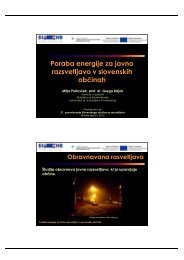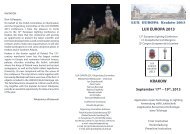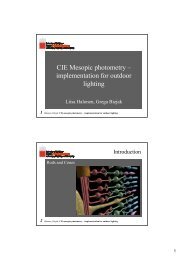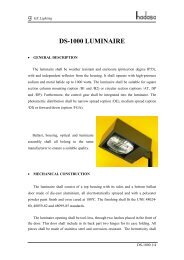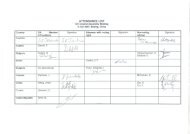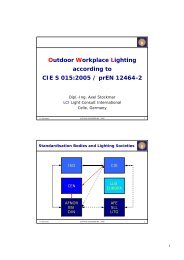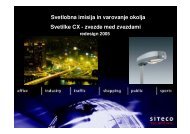Zbornik - SDR
Zbornik - SDR
Zbornik - SDR
Create successful ePaper yourself
Turn your PDF publications into a flip-book with our unique Google optimized e-Paper software.
“Lighting Control Systems To Improve energy performance…” R-5<br />
of free contributions shall be taken into account and daylight availability in buildings can<br />
significantly contribute to improving energy performance of electric lighting installations.<br />
The European Committees for Standardisations (CEN, CENELEC and ETSI) are currently<br />
working on implementing methodologies to calculate the integrated energy performance of buildings.<br />
As far as energy consumption related to electric lighting is concerned, the CEN TC169 is preparing a<br />
standard (prEN 15193: Energy performance of buildings – Energy requirements for lighting) [8]<br />
devised to establish conventions and procedures for the estimation of annual energy requirements of<br />
lighting in buildings. The standard can be used for existing buildings, newly designed or renovated<br />
buildings and it takes a “dynamic” use of electric light into account, considering both daylight<br />
availability and space occupancy. According to European Directive guidelines, the TC 169 is<br />
implementing a method that - despite maintaining the simplification necessary to guarantee design<br />
applicability - sharpens the calculation of energy consumption concerning use of artificial light<br />
management systems based on the integration of natural light or user presence. Once obtained, the<br />
estimate of energy consumption of the lighting plant contributes to defining world energy<br />
performance regarding certifying the building.<br />
Still within the overall framework of tools to implement the indications in the European<br />
Directive, a technical procedure is included that establishes the provisions and methods for<br />
estimating the impact of “building automation” systems on energy performance and energy use in<br />
buildings (prEN 15232: Calculation methods for energy efficiency improvements by the application<br />
of integrated building automation systems) [9]. The standard underlines the role of building<br />
automation systems in increasing functionality and energy efficiency systems, including obviously<br />
artificial lighting plants and screening systems of direct sun radiation.<br />
In addition to indications emerging on energy certification of buildings, greater awareness about<br />
adopting lighting control systems is also due to indications published in a recent technical set of rules<br />
disseminated in lighting-technique circles. The standard CEN 12464 “Light and lighting – Lighting<br />
of work places – Part 1: Indoor work places” [10], in the section Criteria for lighting technique<br />
design at point 4.9 – energy saving – cites that a lighting plant must correspond to lighting<br />
requirements of a particular area without wasting energy. While in the section Lighting requirements<br />
for indoor, visual tasks and activity, use of equipment with adjustable light flow is recommended for<br />
school buildings facilities (school classrooms, evening classrooms and reading rooms).<br />
4 Limits to the popularity of lighting control systems<br />
Despite the potential benefits of using lighting control systems to reduce lighting energy and<br />
enhance lighting quality, their application on a large scale has not yet been achieved, and this lack of<br />
diffusion is particularly true in Italian buildings. Furthermore, it is quite common to come across<br />
buildings where the controls have been disabled because of occupants’ complaints against their use.<br />
Going further into the analysis, it is possible to outline the most relevant aspects that may have<br />
had a negative influence on the use of lighting controls [11]. Often architects or lighting designers are<br />
not well informed about existing control technologies (features and potentials of different solutions,<br />
operating characteristics of each component, etc.). Lighting controls must be compatible with<br />
existing lighting equipment (luminaires, lamps, ballasts and wiring) and since lighting and control<br />
components can be obtained from multiple vendors, the designer must be knowledgeable about their<br />
interactions. Lack of awareness implies a difficulty in choosing and designing appropriate solutions<br />
“Lighting engineering 2006” stran 41



